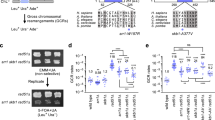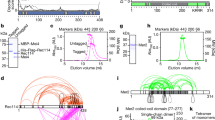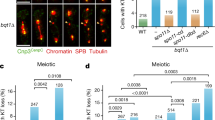Abstract
Structure chromosome (SMC) proteins organize the core of cohesin, condensin and Smc5–Smc6 complexes1. The Smc5–Smc6 complex is required for DNA repair, as well as having another essential but enigmatic function1. Here, we generated conditional mutants of SMC5 and SMC6 in budding yeast, in which the essential function was affected. We show that mutant smc5-6 and smc6-9 cells undergo an aberrant mitosis in which chromosome segregation of repetitive regions is impaired; this leads to DNA damage and RAD9-dependent activation of the Rad53 protein kinase. Consistent with a requirement for the segregation of repetitive regions, Smc5 and Smc6 proteins are enriched at ribosomal DNA (rDNA) and at some telomeres. We show that, following Smc5–Smc6 inactivation, metaphase-arrested cells show increased levels of X-shaped DNA (Holliday junctions) at the rDNA locus. Furthermore, deletion of RAD52 partially suppresses the temperature sensitivity of smc5-6 and smc6-9 mutants. We also present evidence showing that the rDNA segregation defects of smc5/smc6 mutants are mechanistically different from those previously observed for condensin mutants2,3. These results point towards a role for the Smc5–Smc6 complex in preventing the formation of sister chromatid junctions, thereby ensuring the correct partitioning of chromosomes during anaphase.
This is a preview of subscription content, access via your institution
Access options
Subscribe to this journal
Receive 12 print issues and online access
$209.00 per year
only $17.42 per issue
Buy this article
- Purchase on Springer Link
- Instant access to full article PDF
Prices may be subject to local taxes which are calculated during checkout





Similar content being viewed by others
References
Jessberger, R. The many functions of SMC proteins in chromosome dynamics. Nature Rev. Mol. Cell Biol. 3, 767–778 (2002).
D'Amours, D., Stegmeier, F. & Amon, A. Cdc14 and condensin control the dissolution of cohesin-independent chromosome linkages at repeated DNA. Cell 117, 455–469 (2004).
Sullivan, M., Higuchi, T., Katis, V. L. & Uhlmann, F. Cdc14 phosphatase induces rDNA condensation and resolves cohesin-independent cohesion during budding yeast anaphase. Cell 117, 471–482 (2004).
Lehmann, A. R. et al. The rad18 gene of Schizosaccharomyces pombe defines a new subgroup of the SMC superfamily involved in DNA repair. Mol. Cell. Biol. 15, 7067–7080 (1995).
Fujioka, Y., Kimata, Y., Nomaguchi, K., Watanabe, K. & Kohno, K. Identification of a novel non-structural maintenance of chromosomes (SMC) component of the SMC5–SMC6 complex involved in DNA repair. J. Biol. Chem. 277, 21585–21591 (2002).
McDonald, W. H., Pavlova, Y., Yates, J. R. & Boddy, M. N. Novel essential DNA repair proteins Nse1 and Nse2 are subunits of the fission yeast Smc5–Smc6 complex. J. Biol. Chem. 278, 45460–45467 (2003).
Boddy, M. N. et al. Replication checkpoint kinase Cds1 regulates recombinational repair protein Rad60. Mol. Cell. Biol. 23, 5939–5946 (2003).
Hazbun, T. R. et al. Assigning function to yeast proteins by integration of technologies. Mol. Cell 12, 1353–1365 (2003).
Pebernard, S., McDonald, W. H., Pavlova, Y., Yates, I. J. & Boddy, M. N. Nse1, Nse2, and a novel subunit of the Smc5–Smc6 complex, Nse3, play a crucial role in meiosis. Mol. Biol. Cell 15, 4866–4876 (2004).
Verkade, H. M., Bugg, S. J., Lindsay, H. D., Carr, A. M. & O'Connell, M. J. Rad18 is required for DNA repair and checkpoint responses in fission yeast. Mol. Biol. Cell 10, 2905–2918 (1999).
Onoda, F. et al. SMC6 is required for MMS-induced interchromosomal and sister chromatid recombinations in Saccharomyces cerevisiae. DNA Repair 3, 429–439 (2004).
Nyberg, K. A., Michelson, R. J., Putnam, C. W. & Weinert, T. A. Toward maintaining the genome: DNA damage and replication checkpoints. Annu. Rev. Genet. 36, 617–656 (2002).
Melo, J. A., Cohen, J. & Toczyski, D. P. Two checkpoint complexes are independently recruited to sites of DNA damage in vivo. Genes Dev. 15, 2809–2821 (2001).
Lisby, M., Barlow, J. H., Burgess, R. C. & Rothstein, R. Choreography of the DNA damage response; spatiotemporal relationships among checkpoint and rRepair proteins. Cell 118, 699–713 (2004).
Gotta, M. et al. The clustering of telomeres and colocalization with Rap1, Sir3, and Sir4 proteins in wild-type Saccharomyces cerevisiae. J. Cell Biol. 134, 1349–1363 (1996).
Stegmeier, F., Visintin, R. & Amon, A. Separase, polo kinase, the kinetochore protein Slk19, and Spo12 function in a network that controls Cdc14 localization during early anaphase. Cell 108, 207–220 (2002).
Machin, F., Torres-Rosell, J., Jarmuz, A. & Aragon, L. Spindle independent condensation-mediated segregation of yeast ribosomal DNA in late anaphase. J. Cell Biol. 168, 209–219 (2005).
Torres-Rosell, J., Machin, F., Jarmuz, A. & Aragon, L. Nucleolar segregation lags behind the rest of the genome and requires Cdc14p activation by the FEAR network. Cell Cycle 3, 496–502 (2004).
Wotton, D. & Shore, D. A novel Rap1p-interacting factor, Rif2p, cooperates with Rif1p to regulate telomere length in Saccharomyces cerevisiae. Genes Dev. 11, 748–760 (1997).
Seigneur, M., Bidnenko, V., Ehrlich, S. D. & Michel, B. RuvAB acts at arrested replication forks. Cell 95, 419–430 (1998).
McGlynn, P. & Lloyd, R. G. Modulation of RNA polymerase by (p)ppGpp reveals a RecG-dependent mechanism for replication fork progression. Cell 101, 35–45 (2000).
Collins, I. & Newlon, C. S. Meiosis-specific formation of joint DNA molecules containing sequences from homologous chromosomes. Cell 76, 65–75 (1994).
Schwacha, A. & Kleckner, N. Identification of joint molecules that form frequently between homologs but rarely between sister chromatids during yeast meiosis. Cell 76, 51–63 (1994).
Zou, H. & Rothstein, R. Holliday junctions accumulate in replication mutants via a RecA homolog-independent mechanism. Cell 90, 87–96 (1997).
Zhu, Q., Pongpech, P. & DiGate, R. J. Type I topoisomerase activity is required for proper chromosomal segregation in Escherichia coli. Proc. Natl Acad. Sc.i USA 98, 9766–9771 (2001).
Ira, G., Malkova, A., Liberi, G., Foiani, M. & Haber, J. E. Srs2 and Sgs1–Top3 suppress crossovers during double-strand break repair in yeast. Cell 115, 401–411 (2003).
Wu, L. & Hickson, I. D. The Bloom's syndrome helicase suppresses crossing over during homologous recombination. Nature 426, 870–874 (2003).
Osman, F., Dixon, J., Doe, C. L. & Whitby, M. C. Generating crossovers by resolution of nicked Holliday junctions: a role for Mus81–Eme1 in meiosis. Mol. Cell 12, 761–774 (2003).
Machin, F. et al. Condensin regulates rDNA silencing by modulating nucleolar Sir2p. Curr. Biol. 14, 125–130 (2004).
Pearson, C. G., Maddox, P. S., Salmon, E. D. & Bloom, K. Budding yeast chromosome structure and dynamics during mitosis. J. Cell Biol. 152, 1255–1266 (2001).
Huberman, J. A., Spotila, L. D., Nawotka, K. A., el-Assouli, S. M. & Davis, L. R. The in vivo replication origin of the yeast 2 microns plasmid. Cell 51, 473–481 (1987).
Brewer, B. J. & Fangman, W. L. A replication fork barrier at the 3´ end of yeast ribosomal RNA genes. Cell 55, 637–643 (1988).
Tercero, J. A. & Diffley, J. F. Regulation of DNA replication fork progression through damaged DNA by the Mec1/Rad53 checkpoint. Nature 412, 553–557 (2001).
Acknowledgements
We are grateful to T. Tanaka, D. Moazed, K. Bloom, M. Yanagida, A. Verreault, J. Diffley, R. Rothstein and D. Toczyski for reagents, plasmids and strains; and K. Myant for help with the initial development of ts alleles. We also thank J. Diffley and S. Jackson for helpful advice. J.T.-R. was supported by the European Commission (Marie Curie Intra-European Fellowship). This work was supported by the Medical Research Council UK.
Author information
Authors and Affiliations
Corresponding author
Ethics declarations
Competing interests
The authors declare no competing financial interests.
Supplementary information
Supplementary Information
Supplementary figures S1, S2, S3 and S4; supplementary methods, and table S1 (PDF 400 kb)
Rights and permissions
About this article
Cite this article
Torres-Rosell, J., Machín, F., Farmer, S. et al. SMC5 and SMC6 genes are required for the segregation of repetitive chromosome regions. Nat Cell Biol 7, 412–419 (2005). https://doi.org/10.1038/ncb1239
Received:
Accepted:
Published:
Issue Date:
DOI: https://doi.org/10.1038/ncb1239
This article is cited by
-
The SAGA histone acetyltransferase module targets SMC5/6 to specific genes
Epigenetics & Chromatin (2023)
-
Genome control by SMC complexes
Nature Reviews Molecular Cell Biology (2023)
-
Systemic characterization of alternative splicing related to prognosis and immune infiltration in malignant mesothelioma
BMC Cancer (2021)
-
Smc5/6 functions with Sgs1-Top3-Rmi1 to complete chromosome replication at natural pause sites
Nature Communications (2021)
-
Control of structure-specific endonucleases to maintain genome stability
Nature Reviews Molecular Cell Biology (2017)



